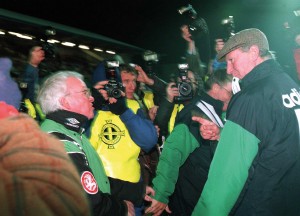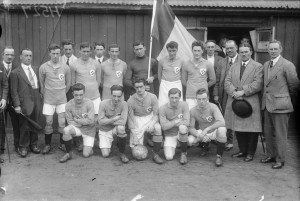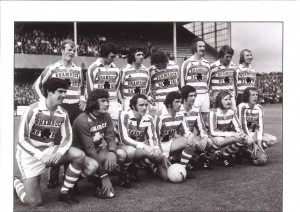The Irish soccer split
Published in 20th-century / Contemporary History, Features, Issue 6 (November/December 2015), Volume 23WHY THIS SMALL ISLAND HAS TWO INTERNATIONAL SOCCER TEAMS
By Cormac Moore
On 7 March 1921, the Protests and Appeals Committee of the Irish Football Association (IFA) met to schedule the replay of an Irish Cup semi-final tie between Dublin club Shelbourne and Lurgan club Glenavon. As the first match, which ended in a draw, had been played in Belfast, it was widely assumed that the replay would be in Dublin. The Protests and Appeals Committee ruled that it was too unsafe for matches to be played in Dublin owing to the prevailing conditions caused by the Anglo-Irish war, and Shelbourne was ordered back to Belfast for the replay. The club refused to comply and was expelled from the competition. The action was roundly condemned by the Leinster Football Association and all associated with the game in Dublin. It was the catalyst that led to the secession of the Leinster body from the IFA and the formation of the Football Association of Ireland (FAI) a few months later.
Belfast bias?
The ordering of Shelbourne back to Belfast was a crass and insensitive move by the IFA. It was, though, just one of many reasons why the Leinster Football Association decided to ‘cut the painter’ and leave the parent body in 1921. Soccer had been governed on an all-Ireland basis since the founding of the IFA in 1880. Many believed that there was an overriding Belfast bias in the selection of players for Irish international teams, the choice of venue for home internationals and the make-up of the IFA council and its subcommittees. From 1882 to 1921, 75 caps were won by players from Leinster clubs to represent the Ireland senior international team. Ulster-based players won 798 caps in the same period. Dublin was the venue for six international matches in that period, Belfast 48. The Leinster and Munster divisions were offered token representation on the IFA council and its different subcommittees. All committees were dominated by Ulster delegates, particularly from Antrim. It was also felt that the IFA was slower to offer funding assistance to Southern-based teams than to Northern ones.
The counter-argument ran, however, that it was from Belfast and its environs that soccer grew, that there were more competitive clubs in Belfast, that it embraced professionalism long before everywhere else did, and that the success of the Belfast clubs in league and cup competitions was testament to the superiority of football in Belfast. In addition, the attendance record at IFA meetings of representatives from Leinster and Munster was poor in the extreme, justifying the decision not to grant them additional representation on key committees.

The split at its most bitter? Northern Ireland manager Billy Bingham has a frank exchange of views with his Republic of Ireland counterpart, Jack Charlton, in the tense and bitter atmosphere of the World Cup qualifier at Windsor Park in November 1993. But how had the split come about? (Inpho Photography)
Was the prevailing political climate at the time the primary reason for the split in Irish soccer? Politics certainly played a major part. Many senior IFA figures were prominent unionists, including the IFA chairman, James Wilton, and the Belfast Telegraph editor, Thomas Moles. The political climate in Ireland in the early 1920s had seen the withdrawal of the Dublin teams from the Irish Football League. Incidents of violence at matches—most notoriously at an Irish Cup tie between Glentoran and Belfast Celtic in 1920, where a mass brawl ensued and revolvers were used—manifested the link between football and the bitterness between nationalist and unionist communities in Belfast. The ‘flag incident’ in Paris in February 1921 showed many in the South that the IFA was not above politics, and that its politics were of a unionist outlook. The incident happened at an amateur international match between Ireland and France, when students bearing the Irish tricolour were removed from the ground on the advice of IFA officials in attendance at the match. Soccer was the only major sport in Ireland governed from Belfast. This posed problems for many. Owing to pogroms in Belfast that led to the deaths and removal from homes and jobs of Catholics on a wide scale, Sinn Féin organised a boycott on goods and companies from Belfast. Under such circumstances, it became increasingly unfeasible for Leinster football to be governed from Belfast.

The Irish Free State soccer team that beat the USA 3–1 in a friendly match in Dalymount Park on the former’s return from the 1924 Paris Olympics. This was the first FAI-selected Irish international team to play on Irish soil, three years after the birth of the association. (NLI)
Although politics contributed to division, the main factor leading to and maintaining the split was a power struggle to govern soccer for all of Ireland. The Leinster Football Association had developed a taste for governing its own affairs during the First World War, when, for practical reasons, soccer was localised into two leagues, a Belfast and District and a Leinster League. Once it did leave the IFA in 1921, it had the mechanisms and personnel to go it alone. When the FAI was founded months after secession from the IFA, it soon gathered momentum. It immediately established an FAI cup and league competition. Eight teams entered the new Football League of Ireland, which left just six in the IFA-controlled Irish Football League. The FAI also received a huge boost from the nationalist Falls and District League in Belfast, who asked to be affiliated to the new body. The FAI also received the support of Munster and Connacht. Unlike the IFA, the FAI could claim to be a truly all-Ireland body, and did so in an application for membership of the international football organisation, FIFA, in March 1922, stating that it was the governing body of the Leinster Football Association, the Belfast and District Football Association, the Athlone and District Football Association and the Munster Football Association. At the inaugural FAI Cup final in 1922, 15,000 were in attendance. The match went to a replay, attracting 10,000 spectators. By contrast, just 5,000 attended the IFA Cup final that year. This new reality meant that the FAI would henceforward be reluctant to be governed as a junior partner by the IFA.
International recognition
The IFA had one major trump card, however—international recognition and competition. Its biggest revenue-earners were the annual fixtures between England, Scotland and Wales. The FAI embarked on a long campaign to be recognised internationally, firstly with the British associations and then with FIFA. The British associations reluctantly recognised the FAI as an association with dominion status in 1923. In reality this recognition meant little, as none of the British associations would play an FAI-selected Irish team until England did so in 1946. The nascent body had far more success with FIFA, gaining full membership of the international body in 1924 on the condition that it would only govern soccer for the 26 counties of the Irish Free State. The FAI changed its name to the Football Association of the Irish Free State (FAIFS) and no longer accepted in its fold teams for the Falls and District League or any other team from Northern Ireland. The FAIFS still had difficulty in obtaining international fixtures. The first four internationals played under its auspices were amateur fixtures, the first two against Bulgaria and the Netherlands at the 1924 Paris Olympics. The first full international only came in 1926 against Italy in Turin.
Attempts to heal the split
It was against this backdrop that attempts were made to end the split between the IFA and the FAIFS. Both Irish associations would meet on a number of occasions in the 1920s and 1930s to attempt to heal the division in Irish soccer. The conferences in 1924 and 1932 came particularly close to bringing the rift to an end. The 1924 conference failed because the FAIFS would not accept the permanent chairman of an agreed body coming from the IFA, and the 1932 one failed because the FAIFS wanted one of the two seats possessed by the IFA on the International Football Association Board (IFAB), the body that still governs the rules of soccer to this day and still has all of the British associations as members. Both demands were only sought by the FAIFS just as agreement was close at hand.
The conferences of the 1920s and 1930s demonstrated that the split was nurtured not only by national politics but also by power. The IFA, the fourth-oldest football association in the world, looked to maintain its status, to concede as little as it could. The FAIFS ultimately would not agree on a settlement unless it was on the basis of total equality, right down to a seat on the International Board. In many ways the conferences failed because the IFA was too cautious in relinquishing its power, being forced by the English FA to do so at different junctures. The FAIFS also contributed significantly to the failure of the conferences, particularly in 1924 and 1932. The Southern body, by adding additional demands just as agreement was close at hand, ensured the collapse of the conferences. The IFA, who genuinely did want a settlement, could rightly be forgiven for thinking that the Southerners were not serious about amalgamation.

The ‘Shamrock Rovers All-Ireland XI’, comprising players from the Republic of Ireland and Northern Ireland, who lost 4–3 to world champions Brazil in Lansdowne Road in July 1973. Soon after, a series of conferences was held between the IFA and the FAI to look at the possibility of forming an all-Ireland team. (SPORTSFILE)
After the 1932 conference, no serious attempt was made for decades to solve the differences between both Irish associations and to bring about union. The relationship between the IFA and the FAI (the southern body reverted to its original name in 1937) was coloured by rancour and distrust. The IFA, seeing itself as the governing body for soccer for the whole island of Ireland, played under the name ‘Ireland’ and selected players born in the Irish Free State for international fixtures until 1950. There was minimal interaction between the two Irish associations for years, such was the level of antagonism. Interestingly, it was soon after the Northern Troubles commenced that real efforts were attempted to bring about union. A series of conferences from 1973 to 1980 saw union become a realistic option once again, with both bodies at least open to the concept of having one international team representing Ireland. The talks focused on issues such as one international team and the organisation of joint competitions, such as the Blaxnit and Texaco tournaments. Harry Cavan, president of the IFA and vice-president of FIFA, seen by many as an opponent of union, commented in 1979 that ‘two teams in a small country like this was nonsensical’. The political climate in Northern Ireland ultimately proved a hindrance to amalgamation. In addition, the success on the field of Northern Ireland in the early 1980s and the Republic of Ireland from the late 1980s lessened the appetite for one Irish international team, leaving Irish soccer today still mirroring the political division between North and South.
Cormac Moore is author of The Irish soccer split, recently published by Cork University Press.
Further reading
N. Garnham, Association Football and society in pre-partition Ireland (Belfast, 2004).
P. Rouse, Sport and Ireland: a history (Oxford, 2015).
















